Dynamic Modeling and Performance Analysis of a Novel Dual-Platform Biped Robot Based on a 4-UPU Parallel Mechanism
Abstract
1. Introduction
2. Kinematic Analysis
2.1. Mechanism Overview
2.2. Position Analysis
2.3. Velocity Analysis
2.4. Acceleration Analysis
3. Dynamics Model of the Biped Robot
3.1. Force Analysis

3.2. Dynamics Analysis
3.3. Numerical Verification
4. Dynamic Manipulability Ellipsoid Index
5. Dynamic Stability
6. Conclusions
7. Limitations and Future Work
Author Contributions
Funding
Data Availability Statement
Conflicts of Interest
Abbreviations
| DME | Dynamic Manipulability Ellipsoid |
| ZMP | Zero-Moment Point |
| DOF | Degree of freedom |
| CoM | Center-of-mass |
| R | Revolute joint |
| P | Prismatic joint |
| S | Spherical joint |
| U | Universal joint |
References
- Huang, D.H.; Fan, W.; Liu, Y.; Liu, T. Design of a Humanoid Bipedal Robot Based on Kinematics and Dynamics Analysis of Human Lower Limbs. In Proceedings of the 2020 IEEE/ASME International Conference on Advanced Intelligent Mechatronics (AIM), Boston, MA, USA, 6–9 July 2020; IEEE: Piscataway, NJ, USA, 2020. [Google Scholar] [CrossRef]
- Shin, H.; Ishikawa, T.; Kamioka, T.; Hosoda, K.; Yoshiike, T. Mechanistic Properties of Five-Bar Parallel Mechanism for Leg Structure Based on Spring Loaded Inverted Pendulum. In Proceedings of the 2019 IEEE-RAS 19th International Conference on Humanoid Robots (Humanoids), Toronto, ON, Canada, 15–17 October 2019; IEEE: Piscataway, NJ, USA, 2020. [Google Scholar] [CrossRef]
- Zade, H.; Varude, A.; Pandya, K.; Kamat, A.; Chiddarwar, S.; Thakker, R. ReQuBiS—Reconfigurable Quadrupedal-Bipedal Snake Robots. In Proceedings of the 2021 IEEE 17th International Conference on Automation Science and Engineering (CASE), Lyon, France, 23–27 August 2021; IEEE: Piscataway, NJ, USA, 2021. [Google Scholar] [CrossRef]
- Yang, X.; She, H.T.; Lu, H.J.; Fukuda, T.; Shen, Y.J. State of the Art: Bipedal Robots for Lower Limb Rehabilitation. Appl. Sci. 2017, 7, 1182. [Google Scholar] [CrossRef]
- Iotti, F.; Ranjan, A.; Angelini, F.; Garabini, M. OmniQuad: A Wheeled-Legged Hybrid Robot with Omnidirectional Wheels. Mech. Mach. Theory 2025, 214, 106125. [Google Scholar] [CrossRef]
- Chen, Z.J.; Xi, Q.X.; Qi, C.K.; Chen, X.B.; Gao, Y.; Gao, F. Fault-Tolerant Gait Design for Quadruped Robots with Two Locked Legs Using the GF Set Theory. Mech. Mach. Theory 2024, 195, 105592. [Google Scholar] [CrossRef]
- Mazumdar, A.; Spencer, S.J.; Hobart, C.; Salton, J.; Quigley, M.; Wu, T.F.; Bertrand, S.; Pratt, J.; Buerger, S.P. Parallel Elastic Elements Improve Energy Efficiency on the STEPPR Bipedal Walking Robot. IEEE/ASME Trans. Mechatron. 2017, 22, 898–908. [Google Scholar] [CrossRef]
- Kumar, M.; Gautam, P.; Semwal, V.B. A Review of Computational Model for Bipedal Robot Walking Using Gait Analysis. In Proceedings of the 2020 International Conference on Emerging Smart Computing and Informatics (ESCI), Pune, India, 12–14 March 2020; IEEE: Piscataway, NJ, USA, 2020. [Google Scholar] [CrossRef]
- Yao, D.J.; Yang, L.; Xiao, X.H.; Zhou, M.C. Velocity-Based Gait Planning for Underactuated Bipedal Robot on Uneven and Compliant Terrain. IEEE Trans. Ind. Electron. 2022, 69, 11414–11424. [Google Scholar] [CrossRef]
- Taheri, H.; Mozayani, N. A Study on Quadruped Mobile Robots. Mech. Mach. Theory 2023, 190, 105448. [Google Scholar] [CrossRef]
- Mikolajczyk, T.; Mikołajewska, E.; Al-Shuka, H.F.N.; Malinowski, T.; Kłodowski, A.; Pimenov, D.Y.; Paczkowski, T.; Hu, F.W.; Giasin, K.; Mikołajewski, D.; et al. Recent Advances in Bipedal Walking Robots: Review of Gait, Drive, Sensors and Control Systems. Sensors 2022, 22, 4440. [Google Scholar] [CrossRef]
- Mou, H.M.; Tang, J.; Liu, J.; Xu, W.Q.; Hou, Y.F.; Zhang, J.W. High Dynamic Bipedal Robot with Underactuated Telescopic Straight Legs. Mathematics 2024, 12, 600. [Google Scholar] [CrossRef]
- Zhang, Y.; Zang, X.; Chen, B.Y.; Zhang, X.H.; Liu, Y.B.; Zhao, J. Type Synthesis of a Novel 4-Degrees-of-Freedom Parallel Bipedal Mechanism for Walking Robot. Adv. Intell. Syst. 2024, 6, 2300384. [Google Scholar] [CrossRef]
- Xie, Z.Q.; Wang, Y.L.; Luo, X.; Arpenti, P.; Ruggiero, F.; Siciliano, B. Three-Dimensional Variable Center of Mass Height Biped Walking Using a New Model and Nonlinear Model Predictive Control. Mech. Mach. Theory 2024, 197, 105651. [Google Scholar] [CrossRef]
- Wang, W.J.; Cai, S.T.; Hu, J.T.; Yang, X.F.; Lu, H.R.; Li, W.J. Design of A Bipedal Robot via Modular Actuator. In Proceedings of the 2022 International Conference on Advanced Robotics and Mechatronics (ICARM), Guilin, China, 9–11 July 2022; IEEE: Piscataway, NJ, USA, 2020. [Google Scholar] [CrossRef]
- Liu, J.; Zhao, D.; Xing, J.D.; Zhang, B.Z.; Jiang, S. Design and Motion Analysis of a Leg Mechanism of an Unmanned Deformable Vehicle. Struct Multidiscip. Optim. 2025, 68, 121. [Google Scholar] [CrossRef]
- Liang, Y.P.; Yin, F.L.; Li, Z.; Xiong, Z.L.; Peng, Z.H.; Zhao, Y.Z.; Yan, W.X. Reduced-Dimensional Whole-Body Control Based on Model Simplification for Bipedal Robots with Parallel Mechanisms. IEEE Robot. Autom. Lett. 2025, 10, 1696–1703. [Google Scholar] [CrossRef]
- Demirel, M.; Kiper, G.; Carbone, G.; Ceccarelli, M. Design of a Novel Hybrid Cable-Constrained Parallel Leg Mechanism for Biped Walking Machines. Robotica 2023, 41, 1778–1793. [Google Scholar] [CrossRef]
- Sugahara, Y.; Carbone, G.; Hashimoto, K.; Ceccarelli, M.; Lim, H.-O.; Takanishi, A. Experimental Stiffness Measurement of WL-16RII Biped Walking Vehicle During Walking Operation. J. Robot. Mechatron. 2007, 19, 272–280. [Google Scholar] [CrossRef]
- Wang, R.C.; Lu, Z.G.; Xiao, Y.H.; Zhao, Y.H.; Jiang, Q.J.; Shi, X.H. Design and Control of a Multi-Locomotion Parallel-Legged Bipedal Robot. IEEE Robot. Autom. Lett. 2024, 9, 1993–2000. [Google Scholar] [CrossRef]
- Tazaki, Y. Parallel Link-Based Light-Weight Leg Design for Bipedal Robots. In Proceedings of the 2019 IEEE-RAS 19th International Conference on Humanoid Robots (Humanoids), Toronto, ON, Canada, 15–17 October 2019; IEEE: Piscataway, NJ, USA, 2020. [Google Scholar] [CrossRef]
- Gim, K.G.; Kim, J.; Yamane, K. Design and Fabrication of a Bipedal Robot Using Serial-Parallel Hybrid Leg Mechanism. In Proceedings of the 2018 IEEE/RSJ International Conference on Intelligent Robots and Systems (IROS), Madrid, Span, 1–5 October 2018; IEEE: Piscataway, NJ, USA, 2019. [Google Scholar] [CrossRef]
- Xia, Z.H.; Zhang, D.; Chen, Y.Y.; Tian, C.X.; Liu, J.; Wu, C.W. A Novel 6 DOFs Generalized Parallel Manipulator Design and Analysis Based on Humanoid Leg. Mech. Mach. Theory 2022, 176, 105029. [Google Scholar] [CrossRef]
- Li, R.Q.; Meng, H.W.; Bai, S.P.; Yao, Y.Y.; Zhang, J.W. Stability and Gait Planning of 3-UPU Hexapod Walking Robot. Robotics 2018, 7, 48. [Google Scholar] [CrossRef]
- Ren, H.H.; Guo, X.J.; He, M.Z.B.; Ma, C.S.; Su, C.Z. Gait Optimization Method for a Large Heavy Load Biped Robot Based on Particle Swarm Optimizer Algorithm. IEEE Access 2024, 12, 172234–172243. [Google Scholar] [CrossRef]
- Li, R.Q.; Hu, W.W.; Wang, C.Z.; Ning, F.P. Configuration Innovation and Stability Analysis of a Hexapod Load-Bearing Mountain Climbing Robot XuanGui. In Proceedings of the 2024 6th International Conference on Reconfigurable Mechanisms and Robots (ReMAR), Chicago, IL, USA, 23–26 June 2024; IEEE: Piscataway, NJ, USA, 2024. [Google Scholar] [CrossRef]
- Gabardi, M.; Solazzi, M.; Frisoli, A. An Optimization Procedure Based on Kinematics Analysis for the Design Parameters of a 4-UPU Parallel Manipulator. Mech. Mach. Theory 2019, 133, 211–228. [Google Scholar] [CrossRef]
- Thomas, M.; Tesar, D. Dynamic Modeling of Serial Manipulator Arms. J. Dyn. Syst. Meas. Control 1982, 104, 218–228. [Google Scholar] [CrossRef]
- Zhang, L.; Li, R.Q.; Ning, F.P.; Chai, C.; Jia, Z.Y. Performance Analysis and Optimization Design of a Dual-Mode Reconfigurable Ankle Joint Parallel Rehabilitation Mechanism. Appl. Sci. 2024, 14, 1757. [Google Scholar] [CrossRef]
- Zhang, X.C.; Rong, Y.; Wang, H.B.; Zhang, S.J. Kinematics and Dynamics Analysis of a New 5-Degrees of Freedom Parallel Mechanism with Two Double-Driven Chains. Machines 2025, 13, 419. [Google Scholar] [CrossRef]
- Zhao, J.S.; Sun, X.C.; Wei, S.T. Kinematics and Dynamics Analysis of a 3UPS-UPU-S Parallel Mechanism. Machines 2023, 11, 840. [Google Scholar] [CrossRef]
- Yoshikawa, T. Dynamic Manipulability of Robot Manipulators. Trans. Soc. Instrum. Control Eng. 1985, 21, 970–975. [Google Scholar] [CrossRef]
- Sun, T.Z.; Ye, W.; Yang, C.; Huang, F.L. Dynamic Modeling and Performance Analysis of the 2PRU-PUU Parallel Mechanism. Mech. Sci. 2024, 15, 249–256. [Google Scholar] [CrossRef]
- Chen, M.; Zhang, Q.; Qin, X.R.; Sun, Y.T. Kinematic, Dynamic, and Performance Analysis of a New 3-DOF over-Constrained Parallel Mechanism without Parasitic Motion. Mech. Mach. Theory 2021, 162, 104365. [Google Scholar] [CrossRef]
- Yoehikawa, T. Translational and Rotational Manipulability Ot Robotic Manipulators. In Proceedings of the 1990 American control conference, San Diego, CA, USA, 23–25 May 1990; IEEE: Piscataway, NJ, USA, 2009. [Google Scholar] [CrossRef]
- Vukobratović, M.; Borovac, B. Zero-Moment Point—Thirty Five Years of Its Life. Int. J. Humanoid Robot. 2004, 01, 157–173. [Google Scholar] [CrossRef]
- Borovac, B.; Nikolić, M.; Raković, M.; Savić, S. ZMP—Where Are We After Fifty-Five Years? Int. J. Humanoid Robot. 2024, 21, 2350030. [Google Scholar] [CrossRef]
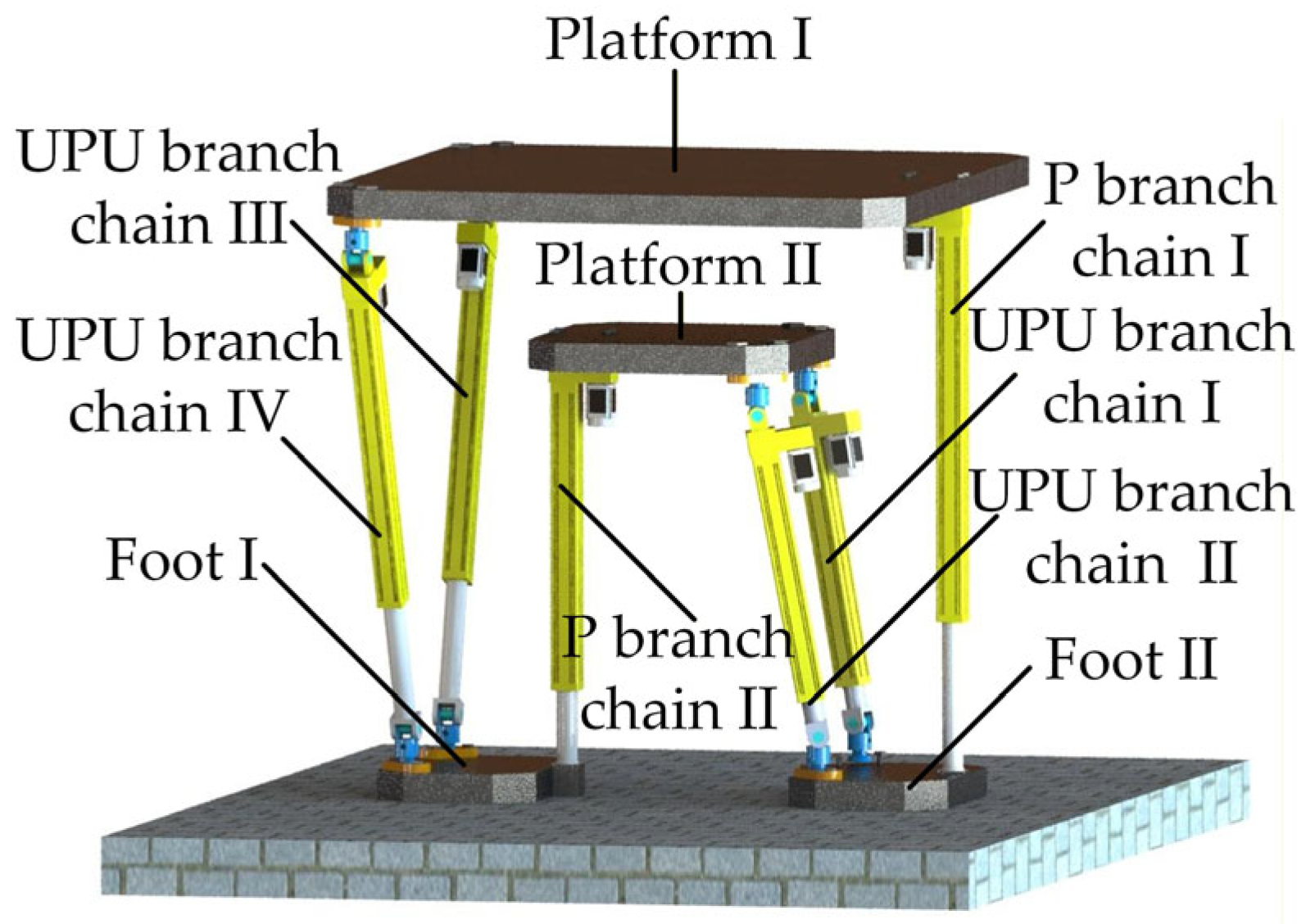
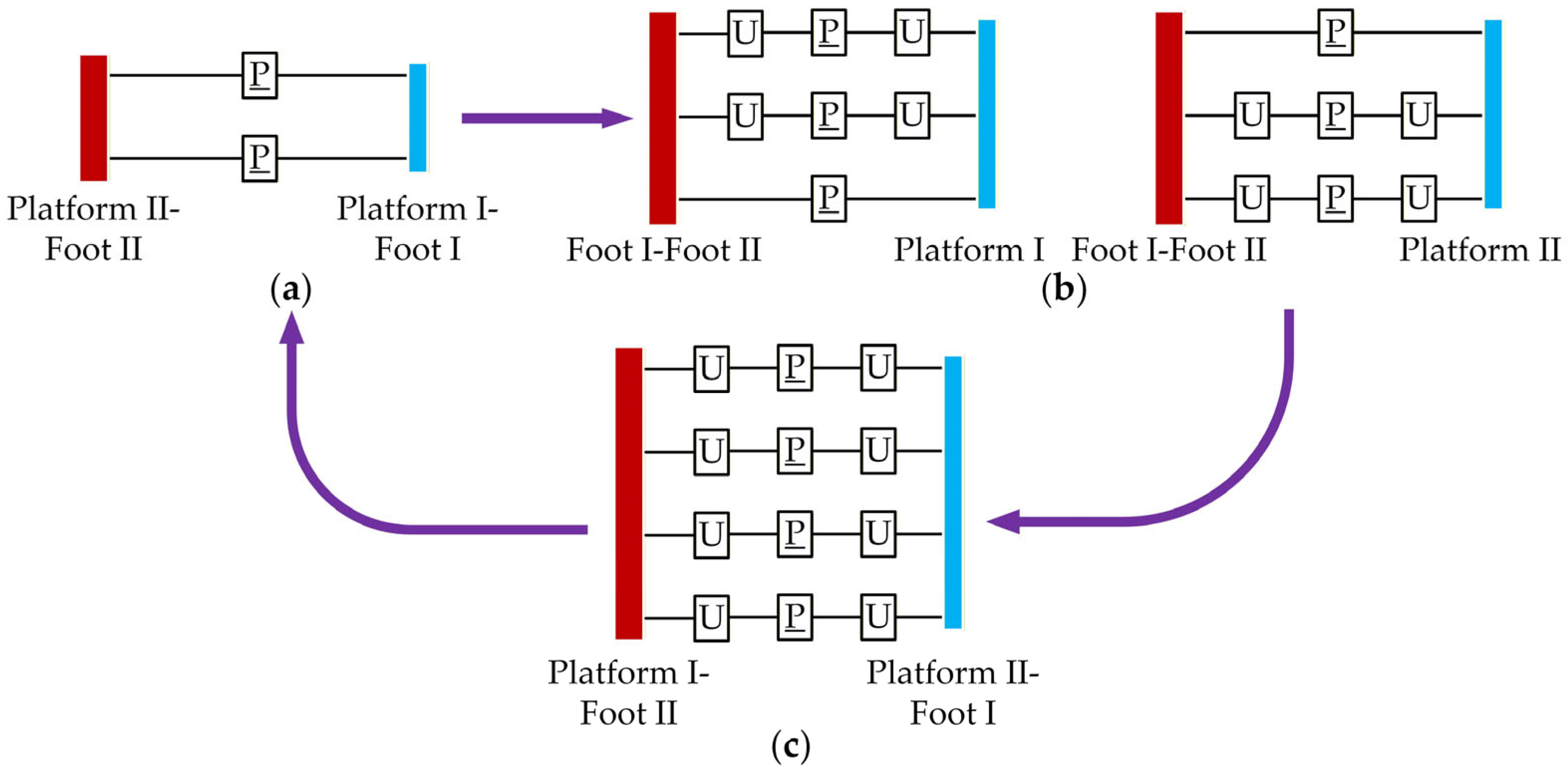
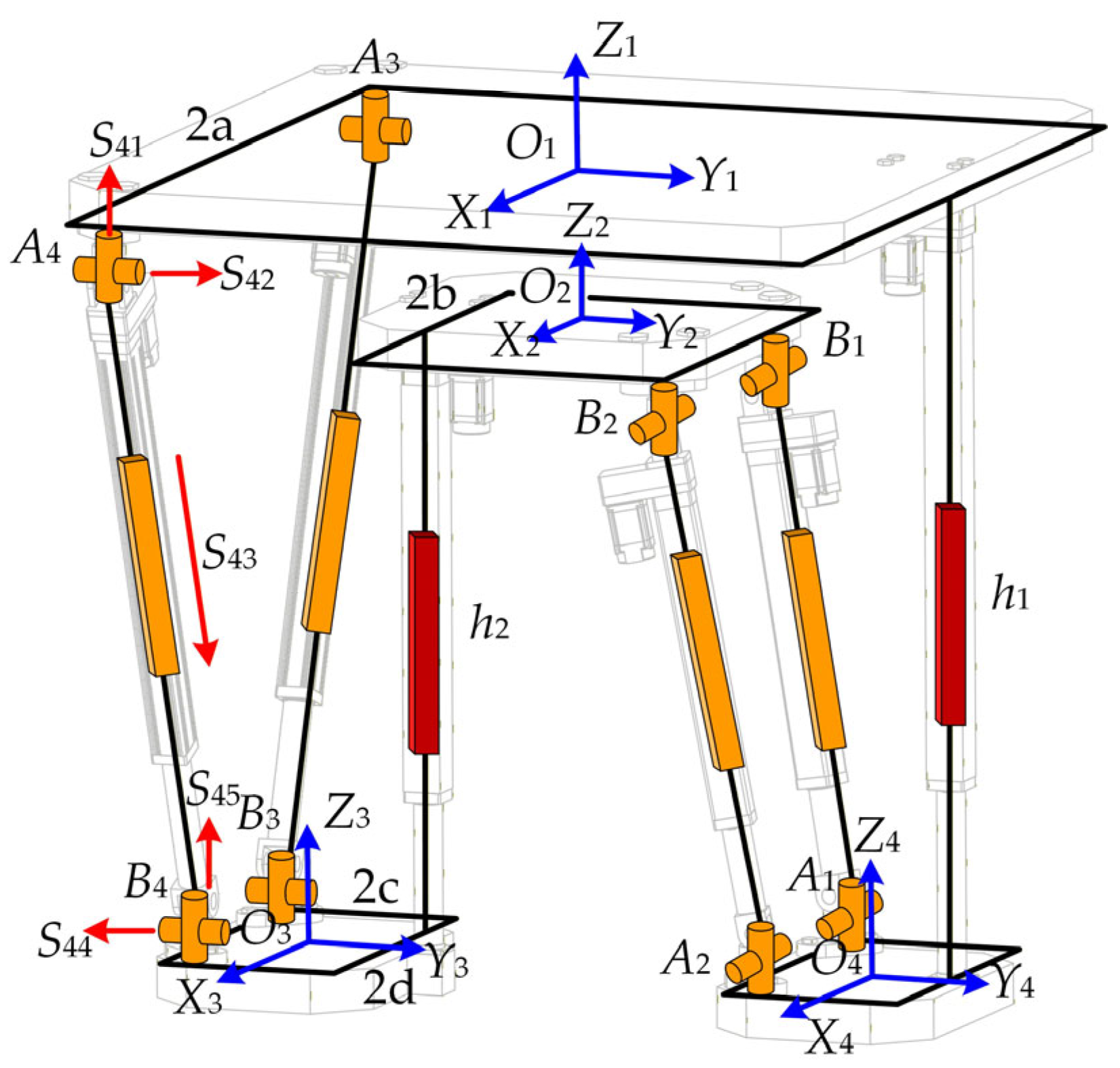
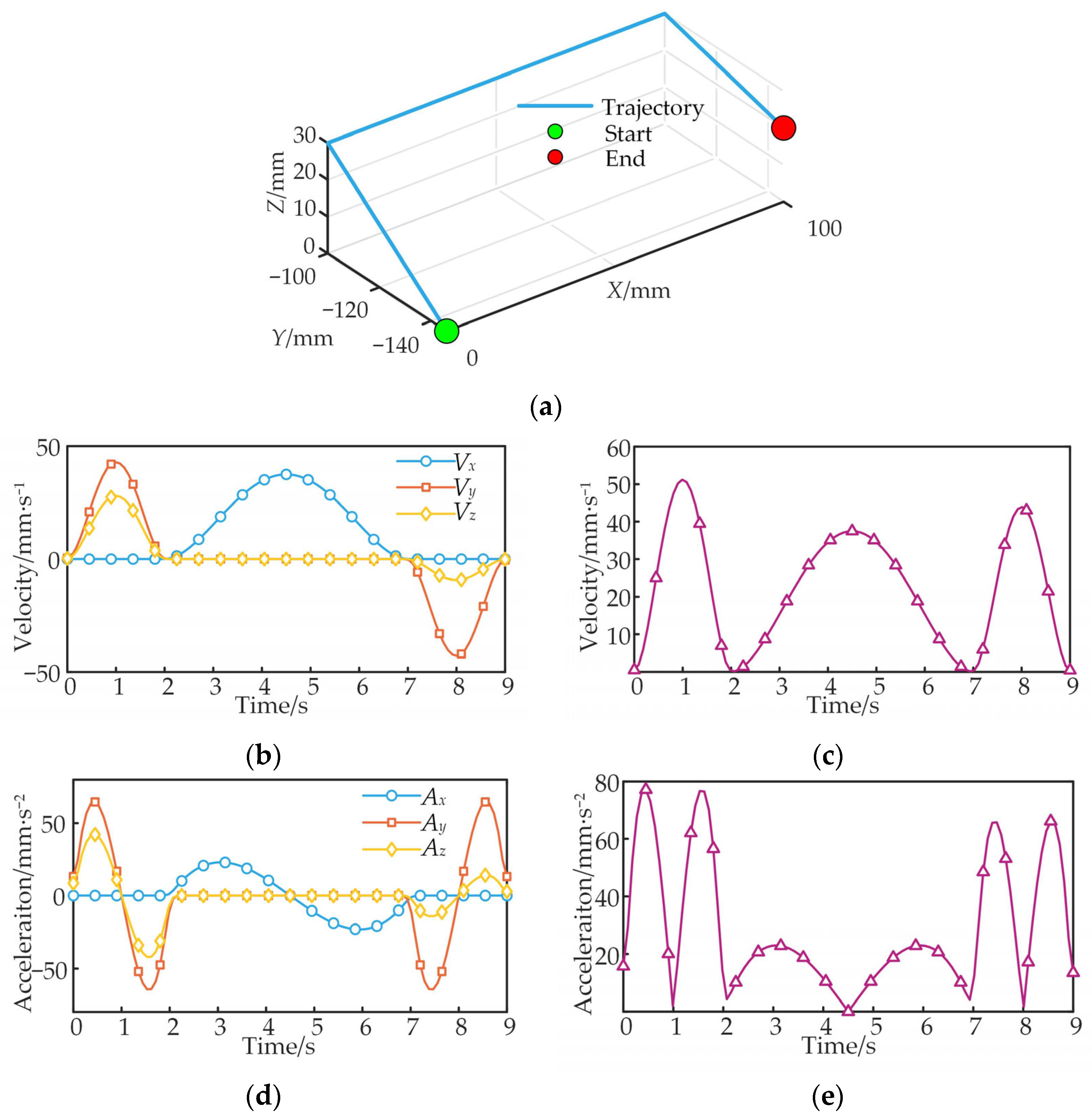
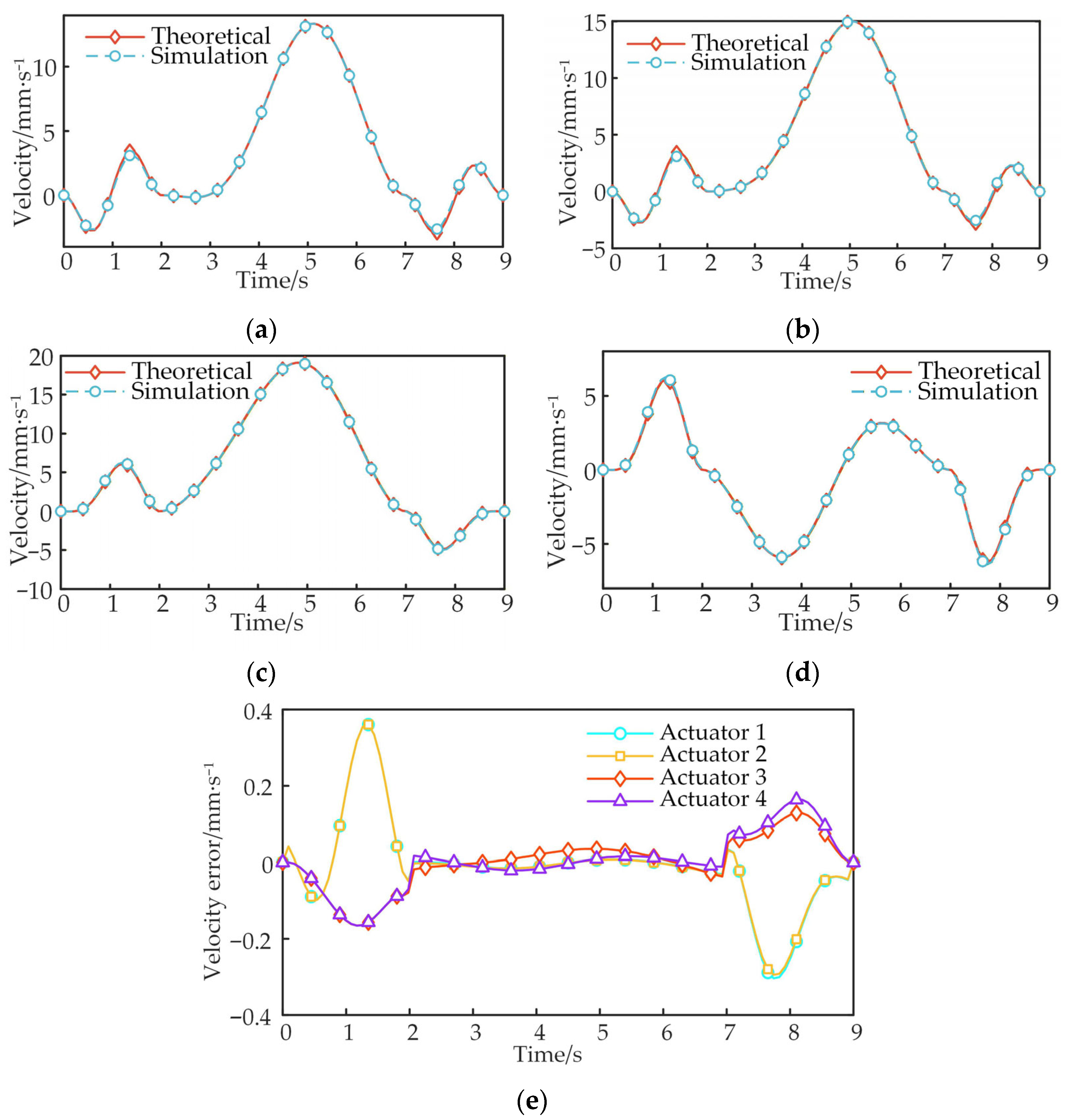
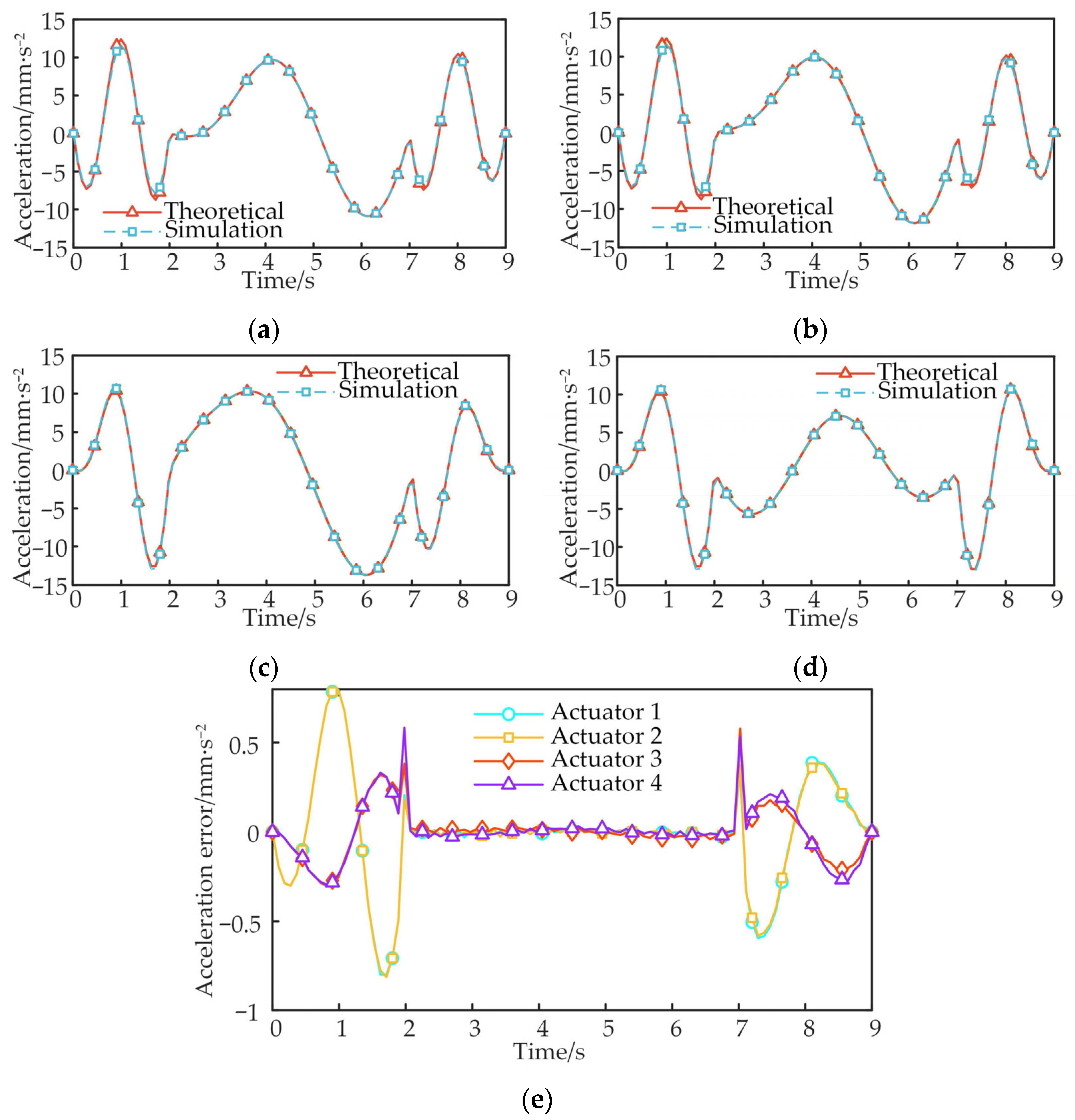
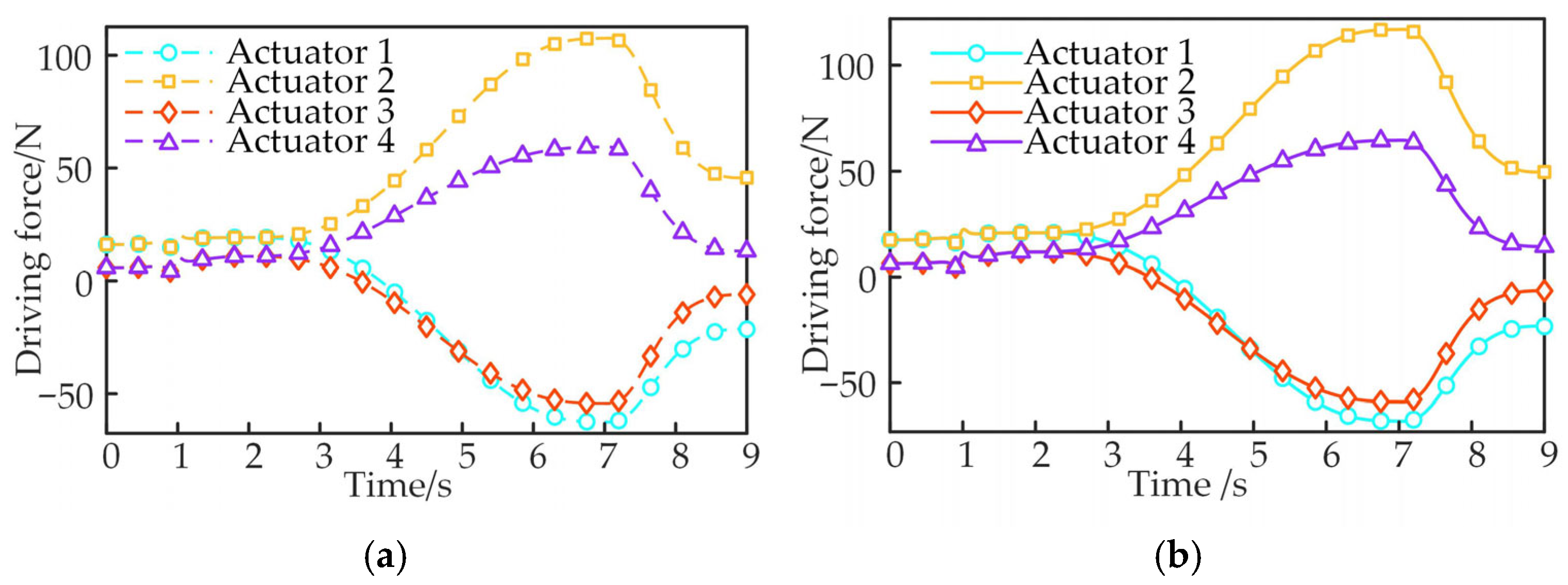


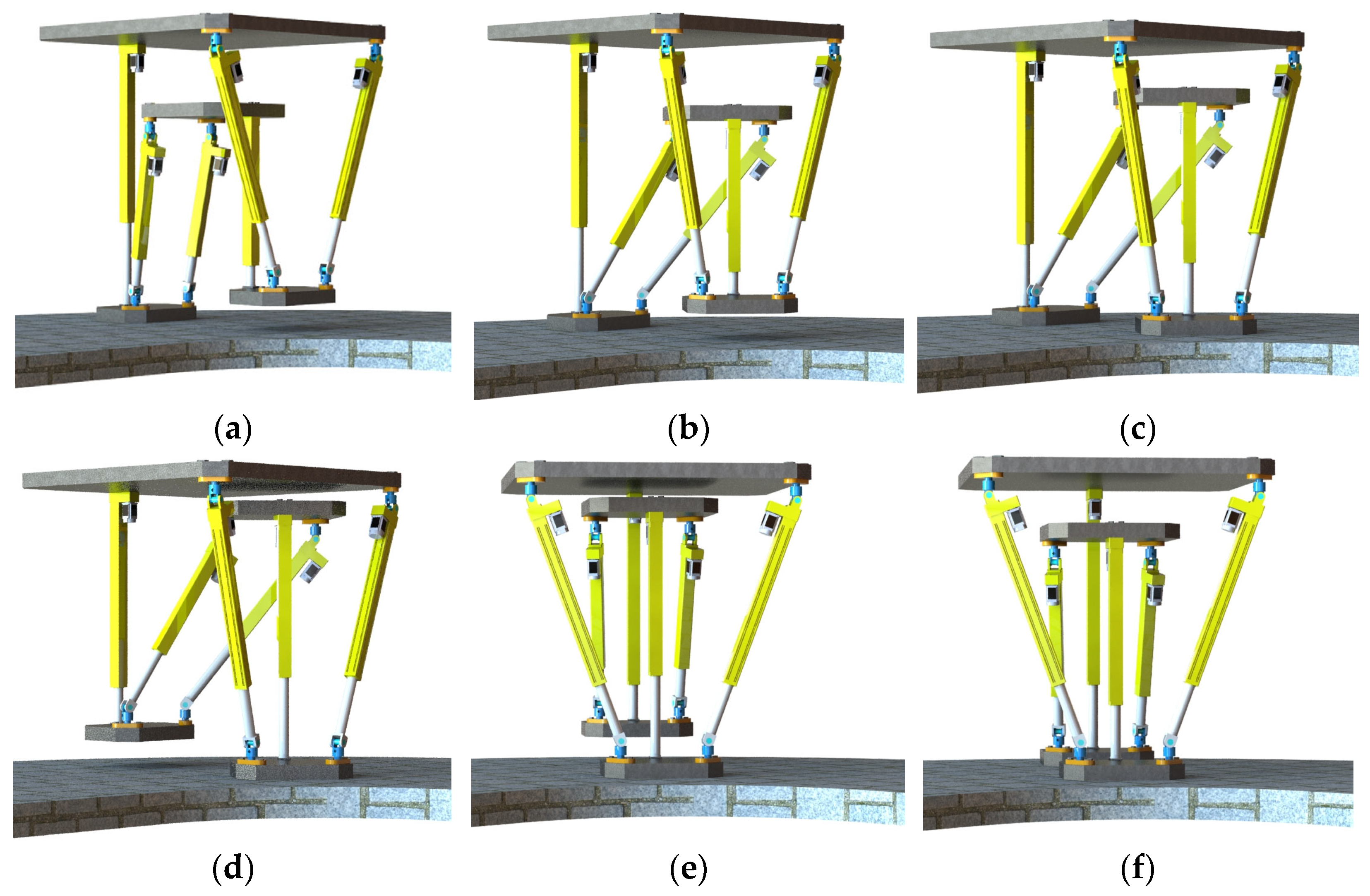


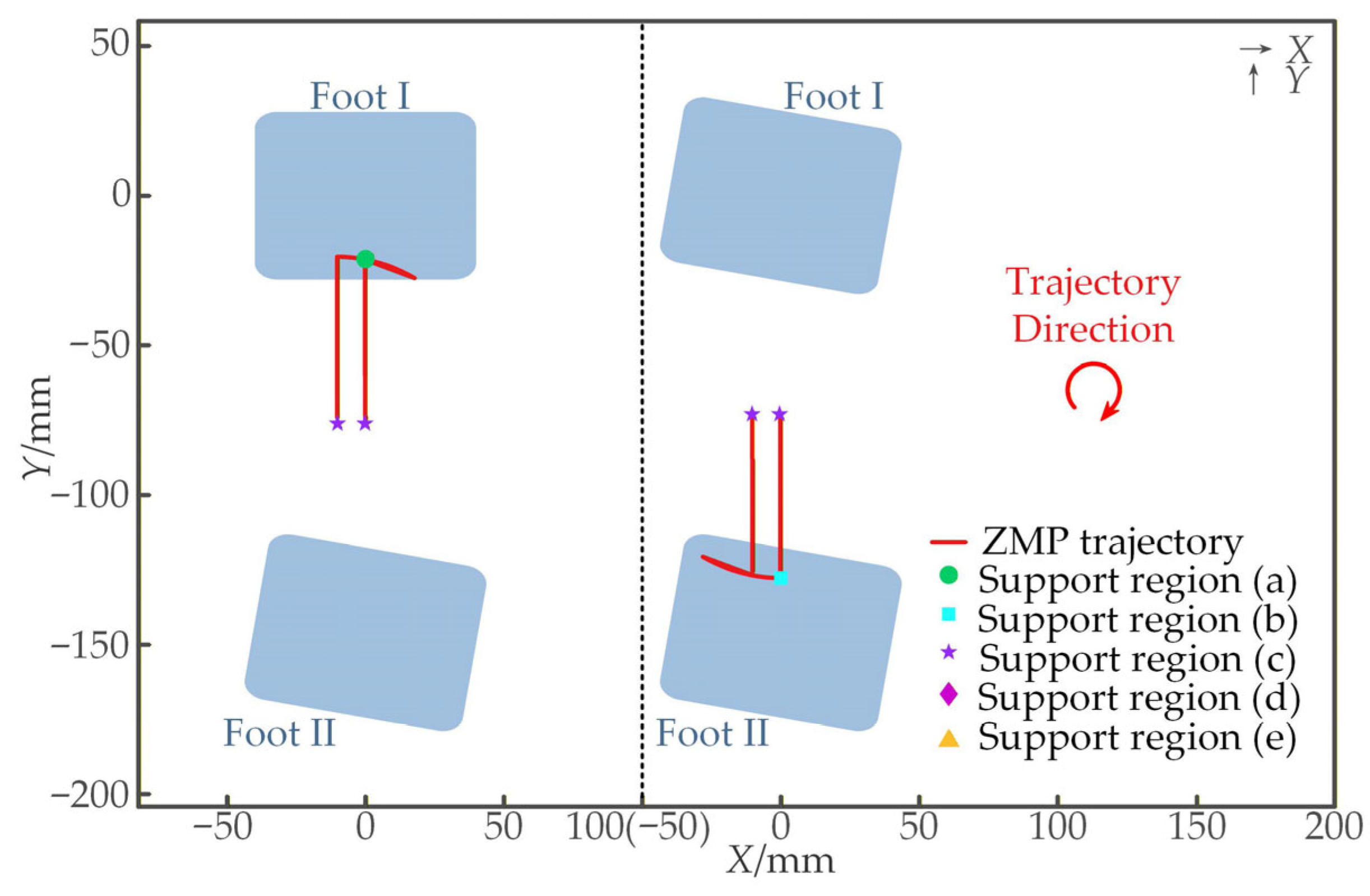
| Biped Robot | DOF | Number of Actuators | Leg Mechanism Type | Gait Characteristics |
|---|---|---|---|---|
| WL-16RIV robot | 6 | 12 | Dual-parallel mechanism | By using a continuous “foot–platform–foot” gait pattern, the robot achieves a wide range of application scenarios. |
| MPLBR robot | 3 | 6 | Dual-parallel mechanism | By using a continuous “foot–platform–foot” gait pattern, the robot can also perform various maneuvers such as jumping. |
| Biped robot based on 6-RSS parallel mechanism | 6 | 12 | Dual-parallel mechanism | By using a continuous “foot–platform–foot” gait pattern, the robot achieves high position-tracking accuracy. |
| Biped robot with hybrid leg mechanism | 6 | 12 | Dual-parallel mechanism | By using a continuous “foot–platform–foot” gait pattern, the robot achieves a large workspace. |
| Humanoid-leg biped robot based on generalized parallel mechanism | 6 | 12 | Dual-parallel mechanism | By using a continuous “foot–platform–foot” gait pattern, the robot exhibits low motion inertia. |
| Four-DOF biped robot | 4 | 8 | Dual-parallel mechanism | By using a continuous “foot–platform–foot” gait pattern, the robot is suitable for maneuvering in confined spaces. |
| Triple-platform biped robot | 6 | 12 | Dual-parallel mechanism | By using a continuous “upper platform + lower foot” gait pattern, but the involvement of two moving platforms makes the walking process somewhat more complex. |
| Dual-platform biped robot (proposed) | 4 | 6 | Single-parallel mechanism | By continuously switching between a moving and fixed platform, the robot achieves a continuous “upper platform + lower foot” gait pattern for locomotion. |
| Component | Mass/g | CoM/mm | Moment of Inertia/g·mm−2 |
|---|---|---|---|
| Moving platform | 1024 | (X, Y + 0.56b + 0.19c, 0.4Z + 0.6h2) T | diag (812,642, 5,395,508, 5,432,171) |
| 8.9 | A1 + 40(B1 − A1)/norm(B1 − A1) | diag (60, 5487, 5490) | |
| 669.8 | B1 + 40(A1 − B1)/norm(A1 − B1) | diag (358,957, 871,888, 888,886) | |
| 8.9 | A2 + 40(B2 − A2)/norm(B2 − A2) | diag (60, 5487, 5490) | |
| 669.8 | B2 + 40(A2 − B2)/norm(A2 − B2) | diag (358,957, 871,888, 888,886) | |
| 674.3 | A3 + 57.5(B3 − A3)/norm(B3 − A3) | diag (378,922, 957,888, 994,747) | |
| 12.6 | B3 + 57.5(A3 − B3))/norm(A3 − B3) | diag (83, 15,285, 15,288) | |
| 674.3 | A4 + 57.5(B4 − A4)/norm(B4 − A4) | diag (378,922, 957,888, 994,747) | |
| 12.6 | B4 + 57.5(A4 − B4)/norm(A4 − B4) | diag (83, 15,285, 15,288) |
Disclaimer/Publisher’s Note: The statements, opinions and data contained in all publications are solely those of the individual author(s) and contributor(s) and not of MDPI and/or the editor(s). MDPI and/or the editor(s) disclaim responsibility for any injury to people or property resulting from any ideas, methods, instructions or products referred to in the content. |
© 2025 by the authors. Licensee MDPI, Basel, Switzerland. This article is an open access article distributed under the terms and conditions of the Creative Commons Attribution (CC BY) license (https://creativecommons.org/licenses/by/4.0/).
Share and Cite
Shi, Z.; Song, S.; Li, R.; Ning, F.; Zhang, L.; Deng, L. Dynamic Modeling and Performance Analysis of a Novel Dual-Platform Biped Robot Based on a 4-UPU Parallel Mechanism. Machines 2025, 13, 1094. https://doi.org/10.3390/machines13121094
Shi Z, Song S, Li R, Ning F, Zhang L, Deng L. Dynamic Modeling and Performance Analysis of a Novel Dual-Platform Biped Robot Based on a 4-UPU Parallel Mechanism. Machines. 2025; 13(12):1094. https://doi.org/10.3390/machines13121094
Chicago/Turabian StyleShi, Zhaofeng, Shengtao Song, Ruiqin Li, Fengping Ning, Lei Zhang, and Lianzheng Deng. 2025. "Dynamic Modeling and Performance Analysis of a Novel Dual-Platform Biped Robot Based on a 4-UPU Parallel Mechanism" Machines 13, no. 12: 1094. https://doi.org/10.3390/machines13121094
APA StyleShi, Z., Song, S., Li, R., Ning, F., Zhang, L., & Deng, L. (2025). Dynamic Modeling and Performance Analysis of a Novel Dual-Platform Biped Robot Based on a 4-UPU Parallel Mechanism. Machines, 13(12), 1094. https://doi.org/10.3390/machines13121094





